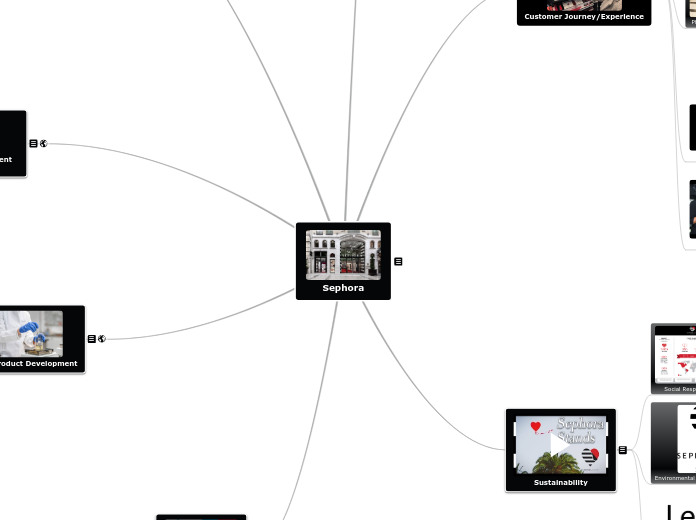Sephora
Celine DAILLY - OPERATIONS MANAGEMENT - IMBA (J3)
In this presentation we will browse some key aspects of operations management at Sephora. We will focus on specific elements that have been important in the development of Sephora and that had led the company to an incredible success. Each topic will be explained and followed by recommendations. Even though Sephora is extremely innovative, we will see how the company can take a step further in order to provide the best experience to its customers while being efficient and remaining on top of the trends in every aspect of its operations.
Take Aways
As we have learned, operations management is the management of processes whose goal is to maximize efficiency while producing goods and services that effectively fulfill customer needs and add value. Studying the operations management at Sephora has been a great learning experience and an efficient way to understand how the theorical concepts are being applied in real life.
Sephora is a leader in the beauty industry (a $532 billion industry) and by looking at the way the company operates, the reasons of its success become evident. Sephora is committed to align its processes and systems to support its strategy to always bring the best to its customers.
As we have seen Sephora strives for excellence in many different aspects of its operations.
- Distribution and Stock management: despite the challenges related to the nature of the business, Sephora put in place a strong supply system that is able to respond to short term changes in demand and supply and ensure timely delivery of products.
- Customer journey/experience: with the use of technology, Sephora reduces a number of pain points for the customer. The company has also developed a set of tools to engage in a more personalized way with its customers, get to know their preferences to continuously improve its service.
- Customer satisfaction/delivering excellent service: Sephora is customer-centric company and ensures constant training of its staff to maintain excellence.
- New product development: Sephora is committed to keep increasing its portfolio with up-and-coming beauty brands while promoting co-creation directly with the customers.
- Sustainability: Sephora responds to climate change by taking a hard look at where emissions and waste can be eliminated from their supply chain.
As we saw, Sephora is always looking for continuous improvement. However not only Sephora follows kaizen approach but also Kaikaku approach. Indeed Sephora is a disruptor in the industry by always challenging the status quo and striving to amaze the customers and bringing operational innovation.
The triple A framework is also embedded in Sephora’s operations. Agility, Alignment and Adaptability have been at the heart of Sephora and has proved to contribute to its success. Even though Sephora could take a step further and become more lean (as exposed in the recommendations for each topic), the company has taken many initiatives to reduce the waste in many aspects of its organization (stock, transportation, waiting, etc.) following the concept of Muda and the lean philosophy.
By putting the technology (artificial intelligence, augmented reality) at the heart of its operations, Sephora is betting on the future. The next step will be for the company to use 3D printing as it will increase its efficiency of production (especially for product development and trial phase) in addition to replace animal testing – thus increasing customer satisfaction.
In the future Sephora could apply its technology and get more profound diagnosis of customer’s health and diagnose deficiency. Sephora could then partner with healthcare companies and develop more personalized products.
New product Development
As we saw in session 13 on New Product Development, when developing a new product, it is essential to adopt a flexible process. This approach consists of sensing the customer needs and receiving feedback from customers, integrating the feedback, testing the product and pivoting if necessary. Sephora is constantly looking to increase its portfolio by bringing unique and exclusive brands to markets that were previously untapped.
Unique and exclusive brands
Sephora has recently partnered with Volition Beauty.
Volition Beauty puts the consumer at the heart of the product development by selecting the best idea that has been suggested. The innovator receives a commission for each unit sold.
Sephora can even go further and adopt the flexible process development to its private label, Sephora Collection, for which Sephora has a 80% margin and that represents an increasing share of Sephora's revenues. Sephora can leverage the data collected through the Virtual artist app to improve its new product development strategy. First, Sephora can get information on a specific product by tracking whether it has been tried but not purchased. In this case, the team can make some changes, not only based on the data but also by involving the community and creating a collaborative approach. In addition, Sephora can develop new products by looking at how other products are performing, as well as the make-up trends by location.
Customer satisfaction/delivering excellent service
As we saw in session 12, delivering excellent service is part of the customer experience and lies in the heart of operations, service quality and customer satisfaction. Sephora is applying the same principles as those we discussed in class:
- Creating and sustaining a strong service culture (15)
- Hiring and rewarding people who can effectively build relationships with customers ->> (12, 10, 8, 7, 5, 4)
- Treating all customers as if they were guests (3)
As hygiene in beauty stores is an issue and could harm dramatically the customer experience and satisfaction, Sephora should improve this aspect as part of its excellence service commitment. Sephora should educate the customers and bring awareness of the dangers of poor hygiene when it comes to the use of cosmetics, encourage the use of in-store technology, and finally get the sanitizing liquids and disposable applicators more noticeable.
Training
In addition, Sephora is committed to continuously improve all parts of the customer experience (Kaizen) through innovation and technology but also by training its employees. In order to build the most knowledgeable and professional team in its stores, Sephora developed "Science of Sephora”, an intensive training program to ensure proficient knowledge of skin physiology, makeup artistry and customer service skills. They also provide some advanced trainings for selected employees
Distribution and Stock Management
Sephora manages several million SKUs combined with several store locations. In addition, Sephora has moved towards an omnichannel retail operation (combining online and offline channel) making the distribution and stock management a crucial aspect of its organization. The nature of the business requires a lot of availability of options and as such Sephora needs to optimize the planning, forecasting and inventory in order to match the supply and demand and maximize the efficiency as discussed in class during session 3. In session 6 we discussed the main challenges faced in stock management: Ensuring shelf availability of products and eliminate out of stock which could lead to a loss of revenue and undermine the customer satisfaction; Avoiding excess inventory that drives up the cost of logistics; Avoiding the express loads that are costly and time consuming. In order for Sephora to face these challenges, reduce the waste and be more lean, the retailer has partnered with Slimstock, an inventory expert providing automated solutions for stock management.
Please watch only the 1st minute of the video, sound off is ok
Sephora should take the next step and go from operational excellence to operational innovation by adopting the RFID technology. This technology is being used by Zara and has proved to be very efficient. More than automating the process, it brings visibility all along the supply chain and give the exact amount of stock in real time.
Introduction
Sephora is a cosmetics and beauty retailer founded in France in 1969, and acquired in 1997 by LVMH. Sephora has built its success thanks to a visionary concept. Inspired by self-service model, Sephora implemented an avant-gardist distribution model that has revolutionized the shopping experience allowing people to freely touch, smell and test the products. Sephora also moved away from the traditional single-brand retail focus, by distributing 300 brands from luxury to niche, out of which 15000 in-store products, ranging from skincare, fragrance, makeup, bath & body, and haircare, in addition to Sephora's own private label. As of today, Sephora has more than 2500 stores in 34 countries. Sephora remains committed to its entrepreneurial spirit in order to always deliver the best of beauty and being accessible to everybody “at Any Time, Any Where on Any Device”.
Sustainability
As we saw in Session 19, operations management contributes to sustainability by implementing best practices that aims at reducing waste and optimizing the resources. Sustainability practices should be embraced and seen as a competitive advantage. There are 3 spheres of sustainability and the 3 should be addressed: Environmental, Social and Economic.
Sephora has understood the challenge of sustainability and its application and has committed to address it by being, once again, innovative in this area.
Sephora could take a step further towards sustainability and have a more integrated approach by looking at its entire supply chain. As an industry leader, Sephora should apply a strict policy to its suppliers to comply with Sephora’s sustainability standards, promote circular economy and green lean management in their operations. An example of best practice in the industry is the South Koran Amore Pacific Group that requires all of its partner organizations to comply with its sustainability guidelines and participate in sustainability assessments. The group also offers trainings, consulting, and mentoring to bring their partners up to speed.
Environmental and Economic Responsibility
Sephora is environmentally responsible and shows its commitment to address the following concerns through various initiatives:
- Saving energy resources and combating climate change: After a thorough audit of its operations, Sephora prepared a detailed carbon report, which identified the 10 most relevant measures to implement to reduce its overall carbon impact. For instance, Sephora has initiated a zero-emissions vehicle “last-mile” delivery program to reduce emissions and transportation-related pollution by using electric trucks. In France this represents a saving of 170.000 tones of CO2 per year. Sephora is expanding this policy to other countries such as Italy where 50% of there stores are currently covered. Sephora has also implemented in its stores an Energy Management System (EMS) and 100% LED lighting. A sensor regulates the temperature both heater and air con. This contributes to a 20% energy consumption yearly.
- Waste recovery: Sephora participates to CEDRE program dedicating to the sorting, recycling, and recovery of all waste generated from the manufacture, packaging, distribution and sale of cosmetic products. The program results in a recycling rate of 88%.
- Protecting ecosystems and natural resources: For its private label, Sephora Collection, Sephora developed a list of substances banned from its products developed in-house due to either their negative environmental impact or toxicity. As an example, Sephora created an ecodesigned lipstick packaging that uses less plastic and more plant-derived inks.
The positive impact of these measures is also part of the economic sustainability of the company.
Social Responsibility
Sephora is committed to unveil the potential of women by acting towards 3 main goals: education, emancipation and self-esteem. Among other initiatives, we can mention the followings:
- Education: Sephora has partnered with an NGO “Toutes à l’école” (“Everyone in school”) https://www.toutes-a-l-ecole.org/en/ and gives access to school to more than 100 little girls in Cambodia each year.
- Emancipation: Since 2012 the job market has been opened to women in Saudi Arabia. Sephora is supporting actively women at work by hiring and providing training to women in its HQ and retail stores in Saudi Arabia.
- Self-esteem: Sephora organizes regularly “Beauty classes” in Spain, France, Italy and Portugal for women in difficulty.
Customer Journey/Experience
As we saw during our field visit at Starbucks, the customer journey experience includes 3 main stages. It starts with the trigger of the need and the initial consideration, it continues when the customer engages and evaluates the purchase, and it finishes once the purchase is made, delivered and ready to be used.
Having a customer-centric and digitally-focused approach, Sephora is using omnichannel strategy in order to provide a seamless shopping experience whether the customer is using an online or offline channel. We will focus here on the key elements that make the customer journey and customer experience at Sephora unique.
Sephora engages with the future customer long before the customer reaches the retail store thanks to the use of advanced technology like chatbot.
Sephora also uses augmented reality to engage with the customer and provide a tailored-made service that contributes to the customer satisfaction.
In-store, Sephora is committed to keep its customer entertained by diversifying its service and providing an experience.
Finally, Sephora aims at reducing the pain points that could impact negatively the customer experience. We will focus here on the payment and collection.
As part of Kaizen or continuous improvement, Sephora could focus on the customer journey for men specifically and make the experience easier. Since men are customers but often non-direct consumers, they encounter a number of pain points such as not finding (and often not knowing) what they are looking for. Sephora could leverage on its data base to give direct suggestions to mean that would decrease the time and stress spent in-store.
Click and Collect
In order to be more lean and reduce the waiting time, Sephora has implemented a system of click and collect where the customers can make an order online and go and pick up his purchase at the store 2 hours later.
Sephora could adopt a more integrated solution spanning the whole customer journey from the initial consideration and recommendation to the moment of purchase and delivery as featured in this video.
Physical Store Experience
During a time where the brick and mortar stores are struggling, Sephora is flourishing. The reason behind this success is because Sephora is not selling products, but instead, provide an experience to its customers. Physical stores provide a wide range of beauty services, such as the hair styling counter called "Dry bar" as well as specialized service areas such as the Nail Bar, the Brow Bar, and the Smile Bar. Customers can come to the store to make their purchases and get pampered at the same time, making the experience memorable.
In the pursuit of constantly improving the in-store customer experience, Sephora could leverage on C&A example and placing big screens in store to inspire the customers with the latest looks (by showing make-up artists for instance). Not only this would keep the customers engaged and entertained, but also the customer would get more ideas that would generate more sales. (watch until 0:55)
Nail bar
Virtual Beauty Experience
Sephora has partnered with Modiface to develop a plateform for virtual beauty (available online and in-store). Thanks to facial analysis and visualization, made possible through the use of artificial intelligence and augmented reality, the plateform addresses the hurdle of buying cosmetics online by closing the gap between seeing the product and envisioning it, boosting conversion rate. Based on the customer data collected previously, Sephora is able to provide a personalized shopping experience by making tailor-made product or service recommendations based on customer preference. Sephora uses personalization to attract and maintain loyal customers. In-store the technology engages the customers and help solve specific consumer pain points by leveraging augmented reality and facial scanning.
Recommendation
Sephora could take a step further and suggest a specific beauty look according to an occasion (cocktail, interview, family dinner) and/or an outfit. Instead of scanning only the face, they could improve the technology that will be able to scan the whole body. This would make the experience of the customer even more complete by providing a complete look.
To go further into the "providing a look" strategy, Sephora could even partner with some retail stores. Based on the make-up style, the app could make suggestions on matching clothes and style and allows the customers to buy the clothes online. In this way, Sephora would be even more innovative and remain ahead of the competition.
Chatbot
Chatbot is an augmented reality assistance that provides a 24/7 personalized service to the customers who have access to a wide range of products they can try virtually, in addition to product recommendations, and beauty tips. Since it is available directly on the mobile phone, it reduces the pain point of going physically to the store. By making the experience easy and immediately available, Sephora engages with its clients at an early stage and this triggers the initial consideration of the purchase.









